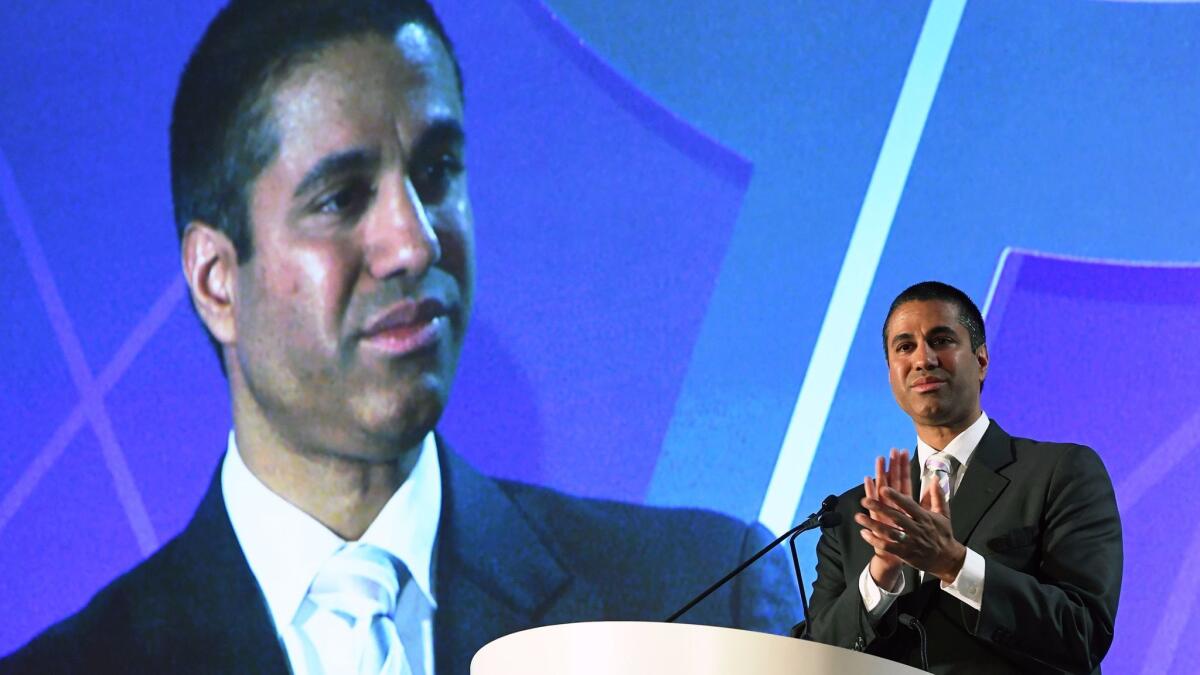FCC chief unveils plan to dismantle net neutrality rules

- Share via
The nation’s top telecommunications regulator unveiled a plan Wednesday to dismantle the tough net neutrality rules for online traffic that Democrats pushed through in 2015 over the objections of major Internet service providers.
Net neutrality regulations are designed to ensure the unfettered flow of online content. They prohibit broadband providers from slowing Internet speeds for some content such as video streams, selling faster lanes for delivering data or otherwise discriminating against any legal online material.
Ajit Pai, a Republican appointed by President Trump to chair the Federal Communications Commission, has been an outspoken opponent of the rules because they subject broadband providers to the same utility-like oversight as conventional phone companies.
Pai said Wednesday that he had sent a proposal to his fellow commissioners that would repeal that regulatory oversight as well as the agency’s vague general conduct standard, which sought to protect Internet users from future unreasonably discriminatory practices.
The Republican-controlled agency is expected to vote next month to open a formal process to repeal the rules, seeking public comment on how to ensure net neutrality without what Pai called “the overhang of heavy-handed regulation.”
One option could be for broadband providers to include net neutrality promises in their terms of service, subjecting them to enforcement action by the Federal Trade Commission if they reneged. Pai did not provide any specific ideas Wednesday, although he has met in recent weeks with telecom and Internet companies seeking input.
His decision to start a rule-making process, which would last for several months, is likely to trigger a repeat of the outpouring of public comments and debate that engulfed the FCC in 2014 when the agency considered the net neutrality regulations.
Democrats, consumer advocates and public interest groups blasted Pai’s move, saying it threatened to give big broadband providers too much power over the Internet.
But Pai said a “light-touch regulatory framework” had allowed the Internet to become “the greatest free-market success story in history.” The FCC needs to return to that approach, he said, instead of a politically inspired Democratic power grab that “put the federal government in control of the Internet.”
“Going forward, we cannot stick with regulations from the Great Depression meant to micromanage Ma Bell,” Pai said in a speech sponsored by FreedomWorks, a libertarian advocacy group, and the Small Business & Entrepreneurship Council.
“Instead, we need rules that focus on growth and infrastructure investment, rules that expand high-speed Internet access everywhere and give Americans more online choice, faster speeds and more innovation,” he said. Pai explained his action in an opinion piece in the Times.
The regulations led the nation’s 12 largest Internet service providers to decrease their capital expenditures on broadband by $3.6 billion, or 5.6%, in 2016 compared with 2014, Pai said.
“It is the first time that such investment has declined outside of a recession in the Internet era,” said Pai, who worked as a lawyer for Verizon Communications Inc. from 2001 to 2003.
Major broadband providers praised Pai’s action, with AT&T Inc. Chief Executive Randall Stephenson saying it would “remove this stifling regulatory cloud over the Internet.”
“Businesses large and small will have a clearer path to invest more in our nation’s broadband infrastructure under Chairman Pai’s leadership,” Stephenson said. “And we are hopeful that bipartisan agreement can be reached on principles that protect Internet openness, consumer choice and vibrant competition.”
Net neutrality supporters have disputed that the regulations led to a decline in investment and said that repealing them threatened the Internet’s future.
“Net neutrality rules keep the Internet open for all and ensure consumers can access the websites and apps they — not their Internet service provider — choose,” said Jonathan Schwantes, senior policy counsel for Consumers Union.
”Rather than leveling the playing field to spur competition and innovation, Chairman Pai’s proposal would allow a select few corporations to choose winners and losers,” Schwantes said.
Mignon Clyburn, the sole Democrat on the FCC, said the tougher regulatory oversight is the only way to ensure that broadband providers don’t favor their own content over that of competitors or try to add so-called toll lanes that allow wealthy companies to pay for faster delivery of video and other services.
“The FCC’s majority will tell you they support an open Internet, but what you should ask them is how they plan to protect it?” said Clyburn, who voted for the 2015 rules. “Actions speak louder than words and the FCC must not take a back seat while the nation’s broadband providers are calling all the shots.”
While there is bipartisan agreement on the goals of net neutrality, there has been a major debate for more than a decade about how to attain them.
After earlier attempts by the FCC to enforce such rules were thrown out by the courts, President Obama and liberal activists pushed the agency to expand its authority over broadband.
They urged the agency to classify broadband as a more highly regulated utility-like service under Title 2 of federal telecommunications law.
About 4 million people filed comments with the FCC when it was considering the net neutrality rules during 2014, with most asking for strong regulation.
But Republicans and major broadband providers such as AT&T opposed the move, saying it threatened to stifle the Internet economy.
Trump publicly expressed his opposition at the time.
“Obama’s attack on the Internet is another top-down power grab,” he tweeted in November 2014.
Pai was outspoken in opposing stricter oversight for broadband service. He tweeted a photo of himself with the 332-page proposal and lamented that FCC rules didn’t allow him to make public what he repeatedly called “President Obama’s Plan to Regulate the Internet.”
In early 2015, the Democratic-controlled FCC voted 3-2 along party lines to reclassify broadband service. Pai and Republican Mike O’Rielly voted against it. Since Trump’s election, control of the commission has flipped.
On Wednesday, Pai said the push for the rules “was all about politics.”
“Did these fast lanes and slow lanes exist? No,” Pai said. “The truth of the matter is that we decided to abandon successful policies solely because of hypothetical harms and hysterical prophecies of doom.”
AT&T, other telecom companies and industry trade groups sued to block the rules, arguing the FCC exceeded its authority in approving the regulations.
In June, a federal appeals court upheld the regulations. The ruling could make it difficult for the FCC to reverse the net neutrality rules.
Pai said he rejected calls for him to simply repeal the regulations through a declaratory ruling. He said he wanted to make the decision “through an open and transparent process in which every American can share his or her views.”
O’Rielly said Wednesday that he supported Pai’s move to repeal the regulations but hoped that Congress would pass net neutrality legislation to provide “lasting peace.”
”Without a statutory resolution, each election could bring large swings in net neutrality positions, preserving uncertainty and confusion for both consumers and industry alike,” O’Rielly said.
Twitter: @JimPuzzanghera
UPDATES:
2:55 p.m.: This article was updated with comments from FCC Commissioner Mignon Clyburn.
12:15 p.m.: This article was updated with additional comments from FCC Chairman Ajit Pai, as well as comments from AT&T Chief Executive Randall Stephenson, Jonathan Schwantes of Consumers Union and FCC Commissioner Michael O’Rielly.
This article originally was published at 11:15 a.m.











